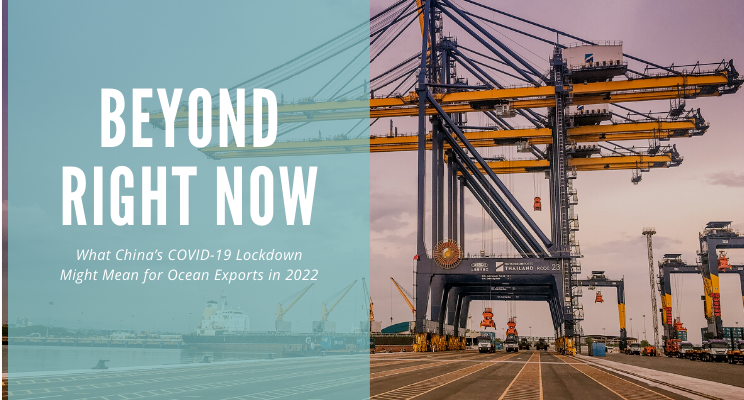Most people know the saying about the butterfly that flapped its wings in the Amazon which led to a hurricane on the other side of the world. Well… if you replace the bird with a bat and the hurricane with a cargo bottleneck off the coast of California, you get a pretty good sense of how Covid-19 has wreaked havoc on ocean exports since early 2020.
The butterfly wings story is part of chaos theory, which states that ‘in dynamical systems, the outcome of any process is sensitive to its starting point.’ With the near total lockdown in Shanghai, we’re seeing this dynamic play out in ways that are complex, fascinating and challenging.
In case you are just returning from a weeks long meditation retreat in Nepal where you have had no access to the news and no need to use your Amazon Prime account, it’s worth restating the latest facts of the situation: the Chinese government has imposed a hard lockdown across the city of Shanghai in an effort to contain a surge in Omicron cases of Covid-19. The hard lockdown started during the last few days of March and is still in full effect today. There have been incredible, and unprecedented scenes of hardship and discontent emerging from China’s famous city as residents struggle to comply with the effects of the zero-Covid policy.
And it’s not just Shanghai either. There are full or partial lockdowns in place in 45 Chinese cities, affecting a quarter of the population and about 40% of the economy. The port of Shanghai is a global key point in the supply chain and its effects are being felt around the world.
What does this mean for ocean exports and global shipping for the rest of 2022?
Let’s start by looking back at some of the lessons learned during the first wave of the pandemic.
The First Wave of Covid-19
No doubt the events of early 2020 are still fresh in most people’s minds. There was a new, unknown virus in China and it was spreading fast. No-one quite knew what to expect. Fear raced around the globe and governments battled to find ways to contain it.
Global trade and shipping cratered fast. All of a sudden there were factories closing their doors, shipping rates went into freefall and empty containers were simply left stranded at ports all over the world. That worldwide hiatus didn’t last long, but it led to tremendous pent-up demand and a real sense of chaos when lockdowns were finally lifted and a surge of orders for the US and Europe had to be fulfilled.
Things are not exactly the same this time around: for one thing, China has not closed all its ports. And while Shanghai is a very important manufacturing and export hub, a number of other Chinese cities will be able to share the burden and ease the logjams in ways that were not possible in 2020.
On the other hand, the world is in a far more precarious position now than it was two years ago when Covid-19 was by far the biggest problem that world of ocean exports had to contend with. Today, things are much more complicated due to the Russian invasion of Ukraine which has caused so much damage, and will do so for the foreseeable future. The price of oil has shot up, the scourge of hunger is threatening many countries that relied on Ukraine and Russia to continue being the ‘breadbaskets of the world’, and with the bruising sanctions that are growing all the time against Russia, many companies are being forced to re-imagine who their partners are and how they operate.
Nothing exists in isolation. With this in mind, we can ask what are the expected implications are of this current Chinese lockdown on ocean exports?
We have three possible scenarios that could play out over the next few months
3 Possible Implications of the China Lockdown for 2022
1) Supply chain diversification has to happen as quickly as possible.
One of the geopolitical solutions that seems to be emerging in the wake of this lockdown is an understanding that there is a need for greater supply chain diversification away from China. That in itself should lead to far greater resilience over the medium term. After all, it stands to reason that when so much of the world’s ocean exports are tied to the fate of one nation, the supply chain will be more vulnerable than it should be.
This is already playing out. FourKites, a Chicago-based company that tracks supply chain data, revealed recently that the volume of goods shipped by sea out of Shanghai has dropped 26% between March 12 and April 4. The volume of goods leaving the port by truck dropped 19% in the same time period.” That’s a significant drop and while immediate solutions are hard to come by, we can see supply chains diversifying over the next few years to build resilience.
2) Will the center of gravity in manufacturing start to shift away from China?
The longer that China’s zero-Covid policy goes on, the more importers, exporters, and freight forwarders will start looking for alternatives. One example of this is the surge in ocean exports that originate in Vietnam. “Traditionally viewed as a regional alternative to China, Vietnam maintained its popularity during the turbulent 2020, and in early 2021 it was named as a top-three sourcing market by a quarter of respondents globally,’ according to SCMP Global Impact Newsletter.
This doesn’t necessarily mean that US companies are breaking their ties with Chinese manufacturers – many of these Chinese companies are relocating to South-East Asia.
Research firm Gartner has long predicted an exodus from China. A survey from June of last year noted that 33% of supply chain leaders had either moved the business out of China or plan to by 2023. That’s a huge shift that will have profound implications for ocean exports in the years ahead.
3) A big test is looming (once again) for California’s ports.
One of the most fascinating aspects of the supply chain disruption of the last few years has been the way in which California has responded to the challenges. The ports of Long Beach and Los Angeles are vital gateways to the whole American economy and their ability to perform or not has global ramifications.
The first two months of this year brought some relief to the overworked ports of California as bottlenecks were cleared and the backlog of ships waiting to dock fell. This is a valuable rebound considering how bad things had gotten by July of last year. That’s when transit time to Los Angeles from China had more than doubled to 62 days. In the months that followed, the number of ships waiting to enter the port at Los Angeles had soared from under 20 to over 75 by mid-October.
The work to clear the backlog and get supply chains back on an even footing has been successful and credit must go to everyone who made that happen. But the queue of ships waiting for Southern California berths has fallen not only because the velocity of moving cargo on land has increased, but also because the volume of goods leaving China has declined. Yet at the same time, we see that imports from Asia had risen by 16.4 percent year-on-year. There is a lot of pentup demand that could be released once again. The end of the lockdown in Shanghai could swamp the California ports again in the coming months.
As we wrote in the OL Bulletin of March ’22, ‘The message for ports, warehouses, railroads, trucking companies, and equipment providers is that the vessel backlogs and choked inland supply chains will likely continue — or worsen — as import volumes accelerate during the summer-fall peak shipping season.’
Conclusion
If there’s a single takeaway from this period of turmoil and upheaval, it’s that creativity is more important than ever. Vigilance and flexibility are required as multiple challenges mount up all fronts, from the rising cost of oil to the tricky issue of complying with sanctions against Russia, lockdowns and occasional worker shortages at various docks in the event of an Omicron outbreak
More and more we are seeing operators in the industry respond creatively; from changing the frequency of shipments, to finding ways to cut miles from distribution networks,, re-imagining partnerships and shifting freight among trucking and intermodal rail. Companies that are agile and unafraid to break the rules will find themselves dominating as the global situation continues to be re-made by events across the world.
Exceptional customer service, live shipment tracking, and a network of agents in over 140 countries are some of the reasons why OL USA is one of the fastest growing international shipping companies in the world. Get in touch today to discover how we can successfully manage every part of your supply chain so you can spend more time serving your customers.



